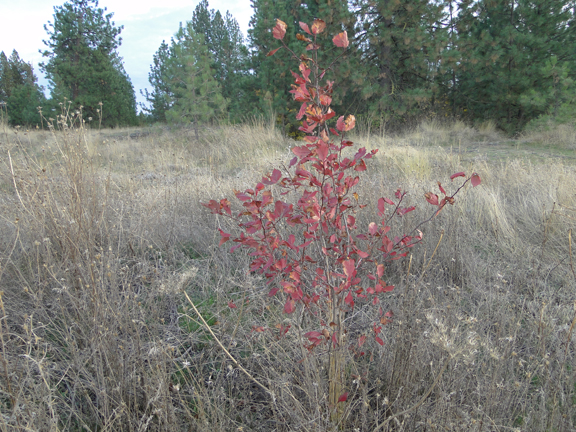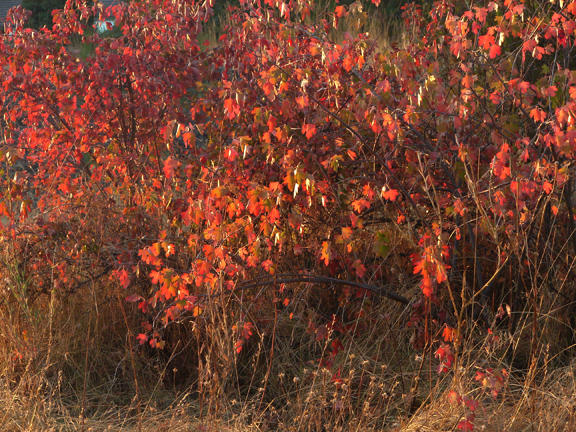There is an article on Ribes aureum by Kathy Lloyd of the
Montana Native Plant Society at the bottom of this entry. Lots of reference to
Meriwether Lewis and uses by Native Americans.
*
Ribes aureum, golden currant, buffalo currant, clove
currant.
Grossulariaceae, Gooseberry family or Currant family.
Formerly in Saxifragaceae family.
First collected by Meriwether Lewis in April of 1806 in what
is now the state of Washington “… on the banks
of the rivers Missouri and Columbia ”. [Probably collected first in Montana .]
Pursh named and described the plant in his Flora of North
America, 1814.
Flora of North America: Three varieties in North
America . Var. Aureum are more highly lobed and are sparsely
glandular in Pacific Northwest and less lobed
and more densely glandular in the southwest.
Robert W. Freckmann Herbarium, University of Wisconsin
Native
It is a woody shrub six to nine feet tall with an irregular
crown.
It propagates by rhizomes and seeds.
Southwest Colorado Wildflowers has a detailed map showing R.
aureum ‘present and not rare’ in counties east to Oklahoma
and Kansas , some in Arkansas . They are ‘present’ in northeast USA and Tennessee
and in most of Canada .
Wikipedia has R. aureum native to Canada ,
northern Mexico and most of
the United States
except the southeast.
Burke Herbarium has R. aureum in Washington
State ’s eastern counties except for
northern tier counties and Columbia
County King County
Jepson finds R. aureum up to 3000 meters. Slichter finds the
between 100 and 400 feet in the Columbia Gorge. I suppose Drumheller Springs
Park
Most Grossulariaceae have spines. Ribes aureum has neither
spines nor prickles.
R. aureum is drought tolerant. Many Grossulariaceae are not.
R. aureum is susceptible to white pine blister rust,
Cronartium rigicola, a fungus. There have been several eradication efforts over
the years. I suppose the reference is to ‘The BRC’, Blister Rust Control, a
major employer of Spokane Youth in the 1950’s.
Leaves
alternate
petiolate
palmate 3 lobed
Turner: Leaves have glands when young.
Flora of North America : Margins of young leaves often with slender
extension like multicelled hairs. Surfaces of leaves sometimes with colorless
or yellowish nearly sessile glands.
The University
of Oklahoma
Digression on ‘Fascicle’:
Wikipedia
A fascicle is a bundle of leaves or flowers. It is in some
cases called a short shoot. The nodes of a shoot are crowded without clear
internodes.
Pine needles are examples of fascicles.
Opuntia spines are fascicles that have nothing to do with
branch morphology.
Latin: fasciculus, diminutive of fascis, a bundle [Fascist
symbol.].
Inflorescence
Flora of North America :
ascending to reflexed. 5-18 flowered racemes. Flowers evenly spaced. Pedicels
jointed.
Bracts:
Flora of North America :
broadly deltate to obvate (similar to leaves).
Flowers
Hermaphrodite but yield is benefitted by cross-pollination.
Fragrant, most say clove like, Wikipedia says clove or
vanilla.
5-18 in clusters
Burke: In ascending or reflexed racemes usually longer than
the leaves.
Flower stalks jointed ‘under ovary’.
Calyx golden yellow, cylindric, 5 calyx lobes spreading.
5 petals yellow to orange or reddish, erect.
Flowers ‘evenly spaced’. I don’t see that in my photographs.
Turner: Petals small in flower center, turning orange or red
with pollination.
Slichter: Petals about half as long as sepals.
Encyclopedia of Life: 5 yellow sepal lobes spreading at the
top with 5 short reddish petals inserted at the top of the tube.
5 stamens equaling the petals, the filaments about equal to
the anthers.
Styles joined almost to the stigmas.
Ovary inferior
Flora of North America :
Hypanthium yellow to yellowish green, narrowly tubular; sepals not overlapping,
spreading, usually not reflexed, golden yellow. Petals connivent [converging
and touching but not fused], erect, yellow to orange to deep red. Not
conspicuously revolute or inrolled. Nectary disc not conspicuous. Stamens
nearly as long as petals; filaments slightly expanded at base. Anthers white.
Fruit
Berries, red to black rarely yellow
Turner: Berries bitter
Numerous seeds.
Branches
Reddish, hairy when young, dark gray, glabrous with age.
Blackfoot Native Plants says it’s a favorite of hummingbirds.
The flowers are said to be eaten by gourmets.
****
Photos
The usual disclaimer. These are photos that I have. Too
often I do not have photos that I need.
Plants
I believe photo 10 is of the earliest R. aureum to leaf-out
and the earliest R. aureum to bloom within the park. It is due north of the
fireplug on Euclid ,
near junction pine on the main trail.
The plant in photo 20 is across the street from the fireplug
on Euclid . It
blooms before any of the plants in the park, perhaps because it gets a little
tender loving care. Ribes aureum has been domesticated from early times in the
history of this country.
Kathy Lloyd of the Montana Native Plant society says Ribes
aureum propagates by rhizomes as well as by seed. Most of the plants I noticed
in the park seemed to be single plants. A couple were ‘brushy’ suggesting
rhizome propagation. One patch, south and east of north pond, near the
high-water is quite large 60.
10-60
April catching evening light on Ribes aureum.
Buds
There is an interesting glandular look to some of the parts.
Turner says the leaves have glands when they are young. Flora of North America :
Margins of young leaves often with slender extension like multicelled
hairs.
So the ‘parts’ with a glandular look must be young leaves.
100-130
Blossoms
The long yellow tube like structure, flaring at the top is
not made up of petals. It is a calyx, made up of sepals, modified leaves.
The petals are the short, vertical structures within the
calyx.
All sources but Turner list yellow, orange or red color for
petals. Turner says the petals turn orange or red with pollination. My photos
suggest that red color is at least an ageing process if not, as in Turner, an
indication of pollination.
The first of these photos of blossoms show petals that are
mostly yellow with some turning. In some photos the sepals are streaked with
color.
200-230
The second set of blossom photos show blossoms with
distinctively red petals.
300-330
Stamen and Pistil
Flora of North America says the anthers are white. I don’t
see white anthers in my photos.
The filaments are said to be ‘about equal to the anthers’.
Perhaps this means that they are short. The filaments are said to be ‘expanded
at base’. I can’t see filaments in my photos. The Styles are said to be 2 that
are fused almost to the stigma. They are said to be ‘about equal to the calyx
lobes’ which suggests that they are very long.
The ovary is ‘inferior’.
400-420
Leaves
The University
of Oklahoma
The shape of the leaves is distinctive but with some
variety.
The color of the leaves through the year is a pleasure.
500-670
Perhaps 530 shows this from Flora of North
America : Surfaces of leaves sometimes with colorless or yellowish
nearly sessile glands.
Stem and Trunk
Sources often remark on the stems being reddish brown and
hairy when young, turning grey and smooth with age.
700-710
The inflorescence is called a raceme. Another task for 2013.
And another: Slichter says racemes are found on leaf bearing
side branches.
800-820
Watching the blossoms dry.
I suppose the green structure at the base of the calyx is a
hypanthium.
900-970
The berries evolve.
1000-1080





























































Great photos!
ReplyDelete